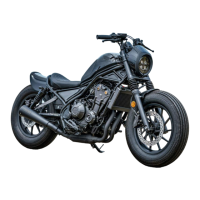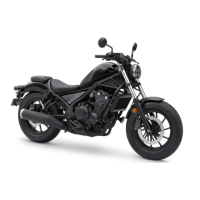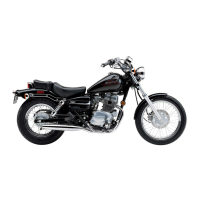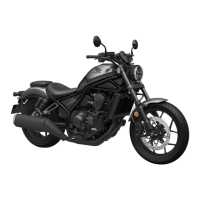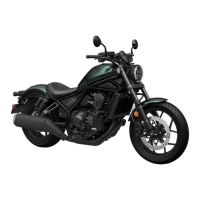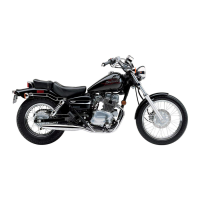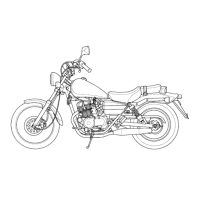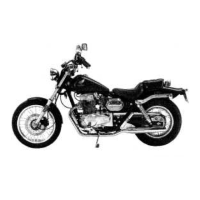Do you have a question about the Honda Rebel 2017 and is the answer not in the manual?
General introduction to safety principles and potential hazards.
Information and warnings provided by labels on the motorcycle.
Precautions for safe operation, including protective apparel and riding.
Precautions for riding, including break-in, brakes, and conditions.
Advice on using accessories and making modifications to the motorcycle.
Guidelines for carrying passengers and cargo safely, including weight limits.
Identifies key components and their locations on the motorcycle.
Explains the motorcycle's dashboard, including display check and controls.
Describes the meaning and function of various warning and indicator lamps.
Details the function and operation of various motorcycle switches.
Provides a step-by-step procedure for starting the motorcycle's engine.
Explains the motorcycle's gear pattern and recommended shift points.
Instructions and warnings for adding fuel to the motorcycle's tank.
Information on locating and using the tool kit and document bag.
Explains why regular maintenance is crucial for safety, performance, and longevity.
Outlines recommended maintenance tasks and their intervals for optimal performance.
Essential principles and procedures for performing motorcycle maintenance safely.
Instructions for safely removing and reinstalling various body parts.
Procedures for removing and installing the motorcycle battery.
Instructions for removing and installing various types of clips.
Procedure for removing and installing harness band clips.
Instructions for removing and installing the motorcycle seat.
Instructions for removing and installing the side covers.
Guidance on checking, inspecting, and replacing the spark plug.
Procedures for checking, adding, and changing the engine oil and filter.
Instructions for changing the air cleaner element to maintain engine performance.
How to check and add coolant to the motorcycle's cooling system.
Procedures for checking brake fluid, pads, and light switch operation.
How to check the proper operation and safety function of the side stand.
Guidance on inspecting slack, wear, and adjusting the drive chain.
How to check and adjust the clutch lever freeplay for proper operation.
Instructions for checking and adjusting throttle grip freeplay.
How to clean the crankcase breather system for optimal engine function.
Procedures for adjusting the headlight aim and rear suspension preload.
How to adjust the vertical aim of the headlight.
How to adjust the spring preload on the rear shock absorbers.
Diagnoses common reasons why the motorcycle engine fails to start.
Addresses overheating issues, identified by the high coolant temperature indicator.
Explains the meaning of PGM-FI and ABS warning lights and their potential issues.
Covers fuel gauge failure indications and other system warnings.
Provides information on emergency tire repair and wheel removal for punctures.
Addresses issues like a dead battery, burned-out bulbs, and blown fuses.
Explains potential causes for intermittent unstable engine operation.
Information regarding ignition and steering lock keys, and key number recording.
Details on ignition switch, engine stop switch, odometer, and ignition cut-off system.
Guidelines for cleaning, polishing, and protecting the motorcycle.
Procedures and recommendations for storing the motorcycle during extended periods.
Safe methods for transporting the motorcycle using trailers or trucks.
Advice on environmentally friendly cleaning and waste disposal practices.
Location and importance of VIN and engine serial numbers for registration and parts.
Information on exhaust, noise, and evaporative emission control systems.
Explains the function of the catalytic converter and how to protect it.
Guidance on using oxygenated fuels and their potential impact on the motorcycle.
Information on obtaining service manuals and other Honda publications.
Details on motorcycle warranties, coverage, and service procedures.
Contact information for American Honda Motor Co. and Honda Canada Inc.
Instructions for reporting potential safety defects to NHTSA and American Honda.
Key physical and dimensional specifications of the motorcycle.
Technical data for maintenance, including tire size, fluid capacities, and spark plugs.
Specifications for motorcycle bulbs, including wattage and type.
Specifications for the motorcycle's fuses, including amperage ratings.
Recommended torque values for various bolts and nuts during maintenance.
General introduction to safety principles and potential hazards.
Information and warnings provided by labels on the motorcycle.
Precautions for safe operation, including protective apparel and riding.
Precautions for riding, including break-in, brakes, and conditions.
Advice on using accessories and making modifications to the motorcycle.
Guidelines for carrying passengers and cargo safely, including weight limits.
Identifies key components and their locations on the motorcycle.
Explains the motorcycle's dashboard, including display check and controls.
Describes the meaning and function of various warning and indicator lamps.
Details the function and operation of various motorcycle switches.
Provides a step-by-step procedure for starting the motorcycle's engine.
Explains the motorcycle's gear pattern and recommended shift points.
Instructions and warnings for adding fuel to the motorcycle's tank.
Information on locating and using the tool kit and document bag.
Explains why regular maintenance is crucial for safety, performance, and longevity.
Outlines recommended maintenance tasks and their intervals for optimal performance.
Essential principles and procedures for performing motorcycle maintenance safely.
Instructions for safely removing and reinstalling various body parts.
Procedures for removing and installing the motorcycle battery.
Instructions for removing and installing various types of clips.
Procedure for removing and installing harness band clips.
Instructions for removing and installing the motorcycle seat.
Instructions for removing and installing the side covers.
Guidance on checking, inspecting, and replacing the spark plug.
Procedures for checking, adding, and changing the engine oil and filter.
Instructions for changing the air cleaner element to maintain engine performance.
How to check and add coolant to the motorcycle's cooling system.
Procedures for checking brake fluid, pads, and light switch operation.
How to check the proper operation and safety function of the side stand.
Guidance on inspecting slack, wear, and adjusting the drive chain.
How to check and adjust the clutch lever freeplay for proper operation.
Instructions for checking and adjusting throttle grip freeplay.
How to clean the crankcase breather system for optimal engine function.
Procedures for adjusting the headlight aim and rear suspension preload.
How to adjust the vertical aim of the headlight.
How to adjust the spring preload on the rear shock absorbers.
Diagnoses common reasons why the motorcycle engine fails to start.
Addresses overheating issues, identified by the high coolant temperature indicator.
Explains the meaning of PGM-FI and ABS warning lights and their potential issues.
Covers fuel gauge failure indications and other system warnings.
Provides information on emergency tire repair and wheel removal for punctures.
Addresses issues like a dead battery, burned-out bulbs, and blown fuses.
Explains potential causes for intermittent unstable engine operation.
Information regarding ignition and steering lock keys, and key number recording.
Details on ignition switch, engine stop switch, odometer, and ignition cut-off system.
Guidelines for cleaning, polishing, and protecting the motorcycle.
Procedures and recommendations for storing the motorcycle during extended periods.
Safe methods for transporting the motorcycle using trailers or trucks.
Advice on environmentally friendly cleaning and waste disposal practices.
Location and importance of VIN and engine serial numbers for registration and parts.
Information on exhaust, noise, and evaporative emission control systems.
Explains the function of the catalytic converter and how to protect it.
Guidance on using oxygenated fuels and their potential impact on the motorcycle.
Information on obtaining service manuals and other Honda publications.
Details on motorcycle warranties, coverage, and service procedures.
Contact information for American Honda Motor Co. and Honda Canada Inc.
Instructions for reporting potential safety defects to NHTSA and American Honda.
Key physical and dimensional specifications of the motorcycle.
Technical data for maintenance, including tire size, fluid capacities, and spark plugs.
Specifications for motorcycle bulbs, including wattage and type.
Specifications for the motorcycle's fuses, including amperage ratings.
Recommended torque values for various bolts and nuts during maintenance.
| Compression Ratio | 10.7:1 |
|---|---|
| Transmission | 6-speed |
| Final Drive | O-ring-sealed chain |
| Front Suspension | 41mm fork; 4.8 inches travel |
| Front Brake | Single 296mm disc with two-piston caliper |
| Front Tire | 130/90-16 |
| Rear Tire | 150/80-16 |
| Trail | 110mm (4.3 inches) |
| Wheelbase | 58.7 inches |
| Seat Height | 27.2 inches |
| Curb Weight | 408 pounds |
| Bore x Stroke | 67mm x 66.8mm |
| Induction | PGM-FI |
| Rear Suspension | Dual shocks with 3.8 inches travel |
| Rear Brake | 240mm disc |
| Rake (Caster Angle) | 28 degrees |
| Valve Train | DOHC; four valves per cylinder |
| Engine Type | 471cc liquid-cooled parallel-twin |


